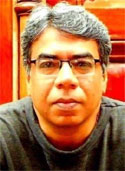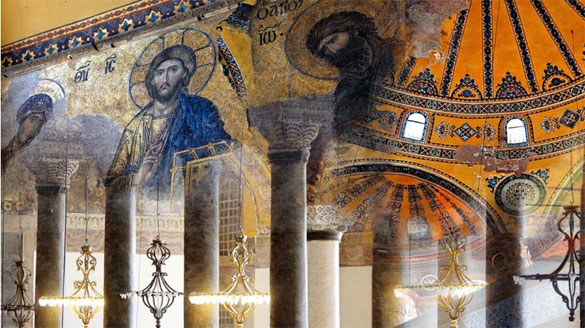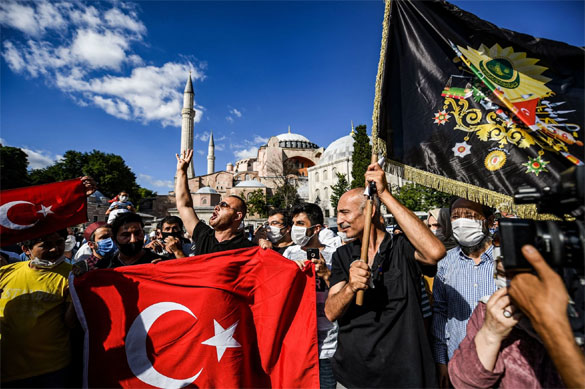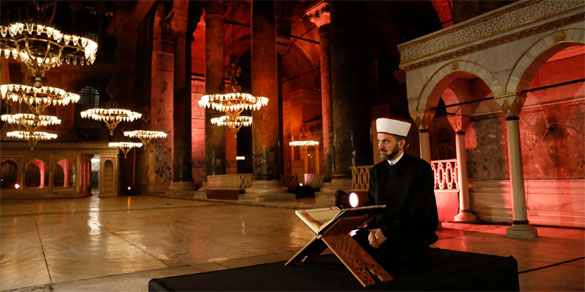Conversion of Hagia Sophia As A Mosque Is Using Religion to Achieve Political Ends

By
Nadeem F. Paracha
19 Jul,
2020
On July 10
this year, a top court in Turkey allowed the country’s government to revert the
status of the iconic Hagia Sophia from a museum to a mosque. The site had been
a museum since 1934. The Hagia Sophia was originally built in the 6th century
as an Orthodox Christian cathedral. But it was converted into a mosque in 1453
when the Ottomans conquered the prized Byzantine capital, Constantinople, and
renamed the city Istanbul.
 Illustration by Abro
Illustration by Abro
-----
However,
nearly 500 years later, the cathedral-turned-mosque was turned into a museum by
the post-Ottoman Turkish Republic formed by Kamal Ataturk. Ataturk, a popular
World War I officer in the Ottoman military, had come to power following
Turkey’s defeat in the conflict. In 1923, he abolished Ottoman rule and
declared Turkey a republic.
Blaming
years of religious obscurantism and a failure to adopt modernity as reasons for
the decline of Muslim political and economic influence, Ataturk initiated a
series of unprecedented secular policies that not only transformed Turkey into
an entirely secular Muslim-majority republic, but it also became a model for
‘modernist’ Muslim leaders and reformers.
However,
from the mid-1970s onwards, because of various mutations in international and
domestic demographic, economic and political trends, the tide of modernity in
this context started to recede and ‘political Islam’ began to find greater
traction in Muslim regions. Many Muslim states adjusted to the change by
adopting elements of political Islam in varying degrees, with some hybridising
it with existing secular laws, and some, such as Iran and Sudan, adopting it
entirely.
The move to
change Hagia Sophia’s status from a mosque to a museum was part and parcel of
Ataturk’s secularisation agenda. He saw the iconic mosque as something that was
a lot more than just a place of worship. He saw it as a former epicentre of
Ottoman influence, just as it had been a major symbol of Orthodox Christianity
during the height of the Byzantine Empire.
 Celebrations outside Hagia Sophia in Istanbul on Friday after a top
Turkish court revoked the sixth-century World Heritage site’s status as a
museum. Credit...Ozan Kose/Agence France-Presse — Getty Images
Celebrations outside Hagia Sophia in Istanbul on Friday after a top
Turkish court revoked the sixth-century World Heritage site’s status as a
museum. Credit...Ozan Kose/Agence France-Presse — Getty Images
----
The new
Turkish republic under Ataturk brought all places of worship under state
control and employed the French idea of ‘laïcité secularism’ that strictly
prohibits any involvement of religion in government affairs. Therefore, neither
could Hagia Sophia be allowed to function as a mosque, because of its political
significance, nor could it be returned to being a cathedral for this very
reason. Instead, it became a museum.
Turkey’s
recent move to revert its status back to being a mosque is being condemned by various
quarters within and outside the country. But there have been celebrations too.
Those defending the reversion claim that many mosques were converted into
cathedrals and churches in Europe. This is a fact. However, these events took
place hundreds of years ago. Otherwise, there is no likelihood of such a thing
happening in a modern secular country. In fact, in the last three decades, the
number of mosques have witnessed a manifold growth in the US and Europe.
Therefore,
a state institution in a secular country allowing a former cathedral to once
again become a mosque has been disconcerting to those who have been warning
about the erosion of secular ideals at the altar of populist impulses, which,
they feel, can have severe long-term effects. It must be added that an Indian
court’s decision, last year, to convert an old, unused mosque into a Hindu
place of worship had triggered similar concerns.
 President Recep Tayyip Erodgan allowed Muslim prayers at Hagia Sophia in
May as part of a ceremony to commemorate the 567th anniversary of the conquest
of Istanbul. Credit...Associated Press
President Recep Tayyip Erodgan allowed Muslim prayers at Hagia Sophia in
May as part of a ceremony to commemorate the 567th anniversary of the conquest
of Istanbul. Credit...Associated Press
---
What the
Turkish court’s decision has also done is that it has given momentum to a
debate in the West which set off after the event of 9/11, event when reports
began to emerge that mosques were being used to radicalise young people.
Suddenly, many in non-Muslim countries began to see mosques in a different
light. Were they more than just places of worship?
According
to Hope Collins in his study of the evolution of mosques (Syracuse University,
2011) the few mosques that were built during the founding years of Islam had
multiple functions. In these mosques, early Muslims prayed, gathered to
formulate laws and military strategies, and to distribute food and booty.
Collins
writes that, in the 640s when Islam began to rapidly expand beyond Arabia, the
mosque was separated from military matters which were shifted to other
buildings of the garrison towns that the Muslims built near the regions they
conquered.
According
to Mohamed Makki Sibai in Mosque Libraries, by 750 CE, mosques began to appear
outside the garrison towns. It was during this period that the world ‘jami’
appeared, derived from the Arabic word jamma, or collective. In the mosque
context, it meant collective prayers. Sibai writes that communal prayers in
mosques became a lot more common after 750 or when mosques began to be built
outside garrison towns.
Collins
writes: ‘In terms of its social functioning, under the Umayyads and the
Abbasids, the mosque became spaces where special occasions would be celebrated,
where the caliphs would receive foreign dignitaries, where tales of morality
would be told, and where poetry would be recited.”
According
to Sibai, markets also began to spring up around mosques during this period.
This is still true around mosques in many Muslim countries. During the Abbasid
period (8th-13th century), mosques also became places of learning, giving birth
to madressahs, where not only religious teaching was imparted, but subjects
such as algebra, geometry, astronomy, philosophy and chemistry were taught as
well.
Interestingly,
according to Collins, “The mosque during the Ottoman period (1299–1922) no
longer enjoyed the levels of political, economic, and educational importance it
had under the Abbasids.” Both Collins and Sibai narrate that the act of
converting a place of worship of one faith with the other is older than Islam.
Muslim rulers began to do this from 705 CE. It was always a political act more
than that of faith, and mostly practised by medieval Muslim and Christian
empires. Collins also writes that the Ottomans used the mosques as
‘bureaucratised tools of the state’ to keep the power of the ulema in check.
With the
fall of Muslim empires in the 19th and early 20th centuries, the mosque became
entirely apolitical. This status was furthered by the emergence of modernist
nationalist regimes and ideas in the Muslim world. But once these ideas began
to waver, and Saudi Arabia rose to become an influential Muslim power from 1973
onwards, the political role of the mosque returned, especially in mosques
funded or built with Saudi money. The 1979 Islamic Revolution in Iran also
contributed to this trend.
Many
mosques became places to recruit, indoctrinate and organise young Muslims,
especially during the anti-Soviet Afghan ‘jihad’ in the 1980s. But today, even
when memories of the commotion and bloodshed caused by such manoeuvres are
still fresh, and even though the tide of so-called ‘Islamist terror’ has
clearly begun to recede, it seems there are still leaders who do not hesitate
to repeat the same mistakes. Erdogan in Turkey is doing it in the name of
‘national sovereignty’; and even Hindu-majority ‘secular India’ has been
seduced by the dangerous idea of using religion to meet certain demagogic political
ends, mistaken as noble acts of piety and nationalism.
Original
Headline: PIETY OR POPULISM?
Source: The Dawn, Pakistan
URL: https://newageislam.com/interfaith-dialogue/conversion-hagia-sophia-mosque-using/d/122417
New
Age Islam, Islam Online, Islamic Website, African
Muslim News, Arab
World News, South
Asia News, Indian
Muslim News, World
Muslim News, Women
in Islam, Islamic
Feminism, Arab
Women, Women
In Arab, Islamophobia
in America, Muslim
Women in West, Islam
Women and Feminism
